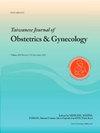Low-level mosaic trisomy 21 at amniocentesis and cordocentesis in a pregnancy associated with a favorable fetal outcome and perinatal progressive decrease of the trisomy 21 cell line
IF 2
4区 医学
Q2 OBSTETRICS & GYNECOLOGY
引用次数: 0
Abstract
Objective
We present low-level mosaic trisomy 21 at amniocentesis and cordocentesis in a pregnancy associated with a favorable fetal outcome and perinatal progressive decrease of the trisomy 21 cell line.
Case Report
A 36-year-old, primigravid woman underwent amniocentesis at 16 weeks of gestation because of advanced maternal age. This pregnancy was conceived by in vitro fertilization and embryo transfer (IVF-ET). Amniocentesis revealed a karyotype of 47,XY,+21 [3]/46,XY [17] (15% mosaicism) and simultaneous array comparative genomic hybridization (aCGH) analysis on the DNA extracted from uncultured amniocytes revealed the result of arr (21) × 2∼3 (X,Y) × 1, consistent with 24.5% mosaicism for trisomy 21. Cordocentesis performed at 21 weeks of gestation revealed a karyotype of 47,XY,+21 [3]/46,XY [37] (6% mosaicism). She was referred for genetic counseling at 31 weeks of gestation, and continuing the pregnancy was advised. The parental karyotypes and prenatal ultrasound were normal. At 37 weeks of gestation, a phenotypically normal baby was delivered with a body weight of 2900-g. The karyotypes of cord blood, umbilical cord and placenta were 47,XY,+21 [1]/46,XY [39] (2.5% mosaicism), 47,XY,+21 [10]/46,XY [30] (25% mosaicism) and 47,XY,+21 [22]/46,XY [18] (55% mosaicism), respectively. Quantitative fluorescent polymerase chain reaction (QF-PCR) analysis on the DNA extracted from umbilical cord and parental bloods excluded uniparental disomy (UPD) 21 and revealed a maternal origin of the extra chromosome 21. When follow-up at the age of 2 months, the neonate was normal in phenotype and development. The peripheral blood had a karyotype of 47,XY,+21 [1]/46,XY [39] (2.5% mosaicism), and interphase fluorescence in situ hybridization (FISH) analysis on uncultured buccal mucosal cells revealed 4.7% (5/105 cells) mosaicism for trisomy 21, compared with 0% (5/100 cells) in the normal control.
Conclusion
Low-level mosaic trisomy 21 at amniocentesis and cordocentesis can be associated with favorable fetal outcome and perinatal progressive decrease of the trisomy 21 cell line.
羊膜穿刺术和脐带穿刺术中的低水平 21 三体综合征与良好的胎儿结局和围产期 21 三体综合征细胞系的逐渐减少有关
病例报告 一位 36 岁的初产妇因高龄而在妊娠 16 周时接受了羊膜腔穿刺术。该孕妇是通过体外受精和胚胎移植(IVF-ET)怀孕的。羊膜腔穿刺术显示核型为 47,XY,+21 [3]/46,XY [17](15%嵌合),同时对未培养羊膜细胞提取的 DNA 进行阵列比较基因组杂交(aCGH)分析,结果显示为 arr (21) × 2∼3 (X,Y) ×1,符合 24.5% 的 21 三体嵌合率。妊娠 21 周时进行的脊髓穿刺显示核型为 47,XY,+21 [3]/46,XY [37](6%嵌合)。她在妊娠 31 周时被转诊到遗传咨询中心,医生建议她继续妊娠。父母的核型和产前超声检查均正常。妊娠 37 周时,一名表型正常的婴儿出生,体重 2900 克。脐血、脐带和胎盘的核型分别为 47,XY,+21 [1]/46,XY [39](2.5%嵌合)、47,XY,+21 [10]/46,XY [30](25%嵌合)和 47,XY,+21 [22]/46,XY [18](55%嵌合)。对从脐带血和父母血液中提取的 DNA 进行定量荧光聚合酶链反应(QF-PCR)分析,排除了 21 号单亲裂殖症(UPD),并发现额外的 21 号染色体来自母体。在 2 个月大时进行的随访中,新生儿的表型和发育均正常。外周血核型为 47,XY,+21 [1]/46,XY [39](2.5%嵌合),对未培养的口腔粘膜细胞进行的间期荧光原位杂交(FISH)分析显示,4.结论在羊膜腔穿刺术和脐带穿刺术中发现的低水平嵌合型 21 三体综合征可能与胎儿预后良好和围产期 21 三体细胞系逐渐减少有关。
本文章由计算机程序翻译,如有差异,请以英文原文为准。
求助全文
约1分钟内获得全文
求助全文
来源期刊

Taiwanese Journal of Obstetrics & Gynecology
OBSTETRICS & GYNECOLOGY-
CiteScore
3.60
自引率
23.80%
发文量
207
审稿时长
4-8 weeks
期刊介绍:
Taiwanese Journal of Obstetrics and Gynecology is a peer-reviewed journal and open access publishing editorials, reviews, original articles, short communications, case reports, research letters, correspondence and letters to the editor in the field of obstetrics and gynecology.
The aims of the journal are to:
1.Publish cutting-edge, innovative and topical research that addresses screening, diagnosis, management and care in women''s health
2.Deliver evidence-based information
3.Promote the sharing of clinical experience
4.Address women-related health promotion
The journal provides comprehensive coverage of topics in obstetrics & gynecology and women''s health including maternal-fetal medicine, reproductive endocrinology/infertility, and gynecologic oncology. Taiwan Association of Obstetrics and Gynecology.
 求助内容:
求助内容: 应助结果提醒方式:
应助结果提醒方式:


